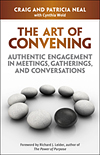Time to Transform Your Meetings #2
/Have you been trapped in a boring Q&A session? There is another way!
One that takes as much time, maybe even less and addresses what most people are thinking and want to hear about.
By Olivia Bretzman with Craig Neal
Have you been trapped in a boring Q&A session?
Wow! The speaker or panel was fantastic, full of great ideas and you are feeling inspired. Then comes the perfunctory Question & Answer period. Hands go up and the 1st question immediately evaporates all the energy in the room. Then another question that may or may not have some relevance...you know what I mean--- we have all been there.
There is another way! One that takes as much time, maybe even less and addresses what most people are thinking and want to hear about.
We developed the BIG Q years ago during a leadership session we convened when the presenter (conversation starter) didn’t stop speaking at the appointed time. As a revered professor and content-deliver, he was great, but oblivious of time, and blew by the planned Q&A. What to do?
With time ticking away we quickly handed cards out to the attendees.
The process:
Each person was asked to record a question on the card. At least one.
Within a defined amount of time, people were asked to READ their question (popcorn style).
Note: We invited repetition and redundancy. it is not a failure of creative thought, but may indicate a theme or meme.We collected the cards and gave them to the presenter to read while we moved to small group circles where people had a conversation about the question they asked.
Prior to the closing of the session, the presenter was given 15 minutes to “report back” to the attendees: What questions were most commonly asked? What he had heard as the key themes? What were the “outlier” questions that were relevant?
Results of the Big Q:
Asking attendees to submit a question engaged everyone at their level of comfort.
Having a number of attendees read their questions out loud gave voice to the diversity as well as similarity of inquiry.
The presenter learned a great deal about the content and affect of his presentation by receiving anonymous input from all in attendance.
Bottom line: Both attendees and presenter reported a broader more comprehensive understanding of the topic due to the inclusive process of the Big Q.
Following that session, realizing the power of the process, we created pre-printed question cards for most meetings or sessions we convened since.
What we have learned in fifteen years of using the BIG Q?
Questions can be more powerful than answers.
Being able to frame a good question is a practiced skill, core to purposeful leadership.
Hearing the questions from the attendees creates a larger “field” of knowledge and awareness for everyone.
Instead of addressing a singular, possibly irrelevant question one at a time, giving the presenter(s) time to reflect and respond to themes that have greater interest to the many is powerful and a timesaver.
Finally, everyone, including the presenter, reports deeper learning and retention.
To learn more about transforming your meetings, gatherings and conversations, check out The Art of Convening Trainings or the book (below).















…this idea of worthiness, that struggle we go through as a nation, happens all the time.
Edward Dugger III, president of Reinventure Capital and an early pioneer in impact investing, explores the intersection between the venture capital community and racial equity.